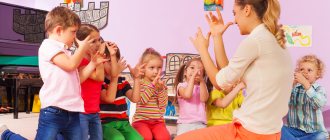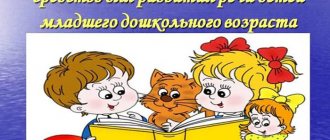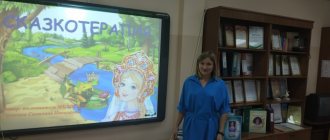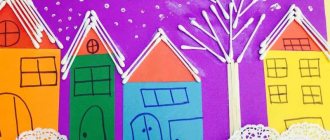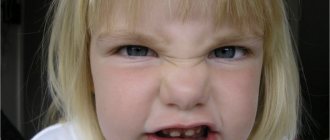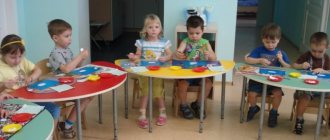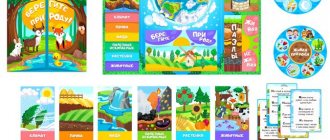No one is surprised that the main activity of children in the preschool period is play, however, there is another important type of activity - productive. In preschool education, productive activity is the activity of a child under the guidance of a teacher, the result of which is the appearance of a product. Many studies have been conducted that have proven that it is thanks to productive activities that older preschoolers develop graphic skills, perseverance and perseverance. Productive activity creates favorable pedagogical conditions for the important process of socialization of children. During this age period, productive activity along with play is crucial for the development of the child’s psyche.
What are productive activities?
A child’s productive activity is a method of activity that aims to produce a product with a specific set of qualities. Productive activities mean the following activities:
- assembly of structures in various ways;
- modeling from special clay or plasticine;
- making all kinds of crafts;
- production of mosaics and applications;
- More challenging activities with different layouts.
All of the above activities are very important for the development of preschoolers. They are included in many kindergarten programs aimed at preschoolers. The goal of such programs is the comprehensive education and development of this age category.
Construction
This is one of the most favorite productive activities of preschoolers. Who didn't love Legos? The peculiarity of the classes is that the children must assemble the object correctly, find the necessary parts and fasten them together. Construction develops spatial orientation, motor skills, creative and logical thinking, aesthetic perception - whether the child likes his creation or not. In addition, the child becomes familiar with the features of parts (color, weight, material from which they are made, shape). The child begins to understand architectural forms in volume, and develops his own taste and opinion.
You can design not only from ready-made parts, but also from paper, boxes, stones, shells, sand; kids learn to recognize parts, combine them, and synthesize them.
Why is productive activity important for a preschooler?
The development process of a preschooler is multifaceted, and productive activities play one of the most important roles in it. Together with games, they merge into a general complex of work devoted to preschool education by the adult generation (educators and teachers). Such activities should lead to the emergence of a specific product. Experts from all over the world have conducted numerous studies with various categories of children who have not yet started school, which have shown how effective productive activity is for this age category:
- It was found that such activities have a beneficial effect on the development of graphic skills, the development of determination and perseverance in the process of mastering various skills.
- Engaging in productive activities contributes to the development of a child’s creative imagination, develops coordination of movements, hand muscles, and thinking mechanisms (synthesis, analysis, ability to compare).
- Like any other cognitive activity, productive activity also plays a significant role in the mental development of children.
- During classes, the most favorable conditions are created for the development of the necessary qualities of initiative, inquisitiveness, independence and curiosity.
- In general, the comprehensive influence of productive activity on the education of preschool children is noticeable.
- A close connection with sensory education is also noticeable. In order to form an idea about objects, it is necessary to first obtain knowledge about their qualities and properties, size, shape, color, position in space.
In the process of productive activity, physical and mental activity simultaneously manifests itself. To create a drawing, an appliqué, or sculpt a figurine, you need to master certain skills, make an effort, and perform creative actions. In the process, preschoolers learn practical skills that they will later need for a wide variety of jobs. They acquire skills that allow children to feel much more independent. The integrated approach is successfully implemented in productive activities. In addition, here children are freed from fears and stress. Modeling of surrounding objects in the process of productive activity ends with the creation of a product in which the idea of a phenomenon, situation or object receives a completely material embodiment in a design, drawing or figurine.
Modeling and applique
The peculiarity of modeling is that a child can create a three-dimensional image of cars, animals, fruits and other favorite objects. The topics are very diverse. Modeling has a great effect on fine motor skills, develops imagination and a sense of space, because after making objects they can be placed further or closer to each other, and satisfies children’s needs for knowledge and creativity.
By creating applications, children learn to independently cut out objects, place them in the right places, and stick objects and elements onto paper. Here, again, the development of finger motor skills and coordination are involved. To create an applique, you need to think hard, think creatively, because the details rarely contain whole and clear objects, so you need to compare them correctly. In addition, the preschooler gets acquainted with mathematics by studying simple geometric shapes. The idea of the placement of objects in space (in the corner, in the center, on the right or left) and the size of parts (large or small triangle) also develops.
You can make a mosaic not only from pieces of paper, but also from lumps. This is also quite entertaining, and no less useful for development.
Areas of productive activity
There are several areas of productive activity:
- creating objects suitable for research and educational activities, as well as for games;
- filling the art gallery with handmade objects;
- creation of layouts;
- creation and design of a “book” filled with children’s stories, a nature diary, a group’s chronicle, and fairy tales;
- production of souvenirs and decorations for holidays in the form of posters, invitation cards, greeting cards, Christmas tree decorations, garlands, etc.;
- inventing a collective story, unusual in that all the words begin with the same letter (such an activity perfectly develops children's oral creativity skills, helps them master writing and reading);
- creating theatrical materials for your performance - making elements of costumes, scenery, etc. Productive activity here is successfully associated with a plot-based children's game or reading fiction.
The work done gives the following results:
- a system of productive activities is being created for older preschoolers;
- children develop creative abilities;
- in a group, children’s psychological well-being improves;
- children are successfully preparing for school.
Typically, productive children's activities are closely associated with such areas as: artistic creativity, cognition, socialization, communication, work, and safety. When engaging in artistic creativity, there is an excellent opportunity to develop children's speech. At this age stage, there are still many problems in children's speech: it is monosyllabic, rather poor (due to an insufficiently rich vocabulary), composed only of simple sentences, and non-literary expressions and words are often used. Also, the use of the method of productive activity has a huge impact on the moral education of children. In the process of performing various practical works, a similar connection is formed and begins to operate in children. In addition, these classes help consolidate knowledge gained from the outside world and develop a number of useful qualities:
- activity;
- observation;
- independence
- determination;
- the ability to finish what you start;
- ability to assimilate received information;
- patience.
Productive activity also affects the physical development of a preschooler. During classes, children's vitality increases, their mood and behavior improve, and their character becomes more active and cheerful. The child himself becomes much more mobile. During classes, it is necessary to develop in children the correct gait, posture and other physical characteristics of the body, which will be very useful for the little person in life. Children's muscles and vestibular apparatus become stronger, and their movements become more coordinated.
Pedagogical sciences/3. Methodological foundations of the educational process
Komleva S. V.
Municipal Educational Institution of Childhood Education "Childhood Support Center", Ekaterinburg, Russia.
Productive creative activity of adolescents: methodological guidelines.
In the modern period of development of Russian society, the successful solution of political, economic and social problems increasingly depends on the action of such a subjective factor as social activity.
Teenagers have a need to convey their attitude to reality through their own journalistic activities. Young people are not indifferent consumers, but socially active thinking individuals. With the help of the media, they want to convey the opinion of their generation to others, influence the course of events, defending an active life position, without remaining indifferent observers. This is precisely the process of socialization of a teenager within the framework of the activity of publishing a newspaper.
The main goal facing a teacher of additional education is to create conditions for the inclusion of young people in creative activities with a specific practical focus. And if the productive creative activity of adolescents
- this is
the goal
, then it can be achieved by solving the following
tasks
:
· give an idea of the means of mass communication, provide professional guidance to high school students;
· teach competent communication, expression and analysis of one’s thoughts, assist in the formation of a teenager’s personal position;
· enable individuals to realize their creative potential, contribute to the preservation of social health and social adaptation;
· provide assistance in the formation of moral and aesthetic criteria, independent thinking, and civic qualities.
Principles
, which are necessary for the implementation of the assigned tasks:
· focus / striving for a common goal /;
· motivation /active, interested attitude towards joint activities/;
· structured /distribution of functions, rights, duties, responsibilities/;
· consistency /coordination of actions of participants in the activity, low level of conflict/;
· organization / planned activities, ability to manage and self-government/;
· effectiveness /ability to achieve results, availability of a real product of activity/.
Planned result
in such activities the following may be the realization of the creative and communicative potential of youth through the journalistic club “Monitor”.
This form of activity is focused on organizing intellectual, socially useful leisure time not only for gifted and talented children, but also for everyone, and is aimed at developing key competencies of the personality of adolescents, contributing to the achievement of results in personal and professional life, ensuring the teenager’s readiness for constructive interaction in social and professional relations.
Productive creative journalistic activity is relevant:
it takes into account the ever-increasing role of the media in the system of social relations, in the creation and strengthening of the ideology of the society within which they exist. In the current mass media system, teenagers, however, do not always have the opportunity to participate in the work of “adult” media. The teenage press, in this case the journalistic club “Monitor,” helps provide them with constant journalistic practice. The role of organizers, authors, and proofreaders is played by the teenagers themselves when interacting with the teacher.
The role of the teacher
additional education in the implementation of this program is more of a guide than an organizer. The teacher, in the truest sense of the word, is the same subject of activity as the student. He does not dominate children, but generously shares his cognitive potential, directing the creative energy of adolescents in the right direction, providing the necessary help in case of difficulties, developing the communication skills of students.
A special feature of additional education is the absence of strict regulations. The teacher has the freedom to choose the content, forms, means, and methods of teaching activities. On the one hand, this makes it possible to act in accordance with one’s own views and beliefs. On the other hand, the teacher’s personal responsibility for the choice made increases. In addition, the absence of strict regulations requires the teacher to take initiative.
Teacher creativity is a necessary condition for effective additional educational activities to create a newspaper.
When creating conditions for productive creative activity, special attention should be paid to methodological support.
Methods and means
additional education are methods and means of teaching, the choice of which is determined by the content and form provided for by the given program.
Among them, one can highlight methods of organizing educational and cognitive activities:
methods of obtaining new knowledge (story, explanation, conversation, working with dictionaries, organizing observation, illustration, demonstration); methods for developing skills and accumulating experience (exercises, practical activities, analysis of the product of activity).
The effectiveness of mastering any type of activity largely depends on the students’ motivation
to this type of activity. Activities proceed more effectively and produce better results if the student has strong, vibrant and deep motives that evoke a desire to act actively, overcome inevitable difficulties, persistently moving towards the intended goal.
The leading role in stimulating methods is played by the interpersonal relationship between adults and adolescents. Group of stimulation methods
can be conditionally divided into three large subgroups: methods of emotional stimulation (creating situations of success, encouragement and reprimand, the use of games and game forms, setting up a system of perspectives); methods for developing cognitive interest (forming a readiness to perceive educational material, building a field of practical application around the material, a method of stimulating with entertaining content, creating a situation of creative search); methods of forming responsibility and commitment (the perspective of the final result - the product of activity, non-interference of the teacher in the process of organizing and performing role-playing activities).
Introduction of methods for organizing interaction
teenagers and the accumulation of social experience contributes, firstly, to the accumulation of social communication experience among students and, secondly, to the development by teenagers of social methods of organizing developmental and educational activities.
The formative element in these methods is dialogical communication
students.
Dialogue forms and supports joint educational activities in the classroom, in which the development of participants in a common cause occurs. methods for organizing the interaction of participants
can be distinguished mastering the basic norms of conversation; peer verification methods; method of joint tasks, jointly finding the best solution; temporary work in groups; creating situations of shared experiences; discussion.
Additional education effectively develops a number of features not provided for in the traditional curriculum. We are talking about the ability for reflection, imagination, the ability to take risks without fear of a possible mistake, the ability to independently develop a program of one’s actions and implement it, and the ability to be creative.
Psychological methods for the development of mental functions and creative abilities
teenagers dominate in the organization of this form of work. The greatest effect is achieved by methods such as: creative task; posing a problem or creating a problematic situation; creation of a creative field; transition from playful to real-practical activities; analysis of the product of activity.
Newspaper release –
one of the popular forms of organizing additional education. This has long been a widely known form of organizing students’ extracurricular activities.
In the process of becoming familiar with working with the printed word, there are many advantages: journalism develops attention and observation, composure and criticality, the ability to master the word and navigate the increased flow of information. Working on publishing a newspaper helps teenagers express themselves and, to some extent, is career guidance. A modern person must have excellent knowledge of information technology. Web design expands the possibilities in the design of material and creates a certain culture of working with text. A newspaper published by printing increases the status of both the press itself and the prestige of working in the youth editorial office.
The main thing around which educational activities are built is the publication of a real newspaper with a specific circulation.
A youth newspaper as an information center allows you to influence high school students and students through the content of published materials, helps to improve information culture, familiarize yourself with modern printing technologies, and master practical skills.
Features of different types of productive activities
In the process of child development activities, the development of artistic and aesthetic qualities corresponds to a modulating type of productive activity. It is with the help of this method that it is easiest for a preschooler to display, at his own discretion, the reality that surrounds him. The characteristic obtained as a result of the conclusions made allows the preschooler to independently create the images he has chosen. Thanks to this approach, children develop excellent imaginative thinking and learn to realize their own imagination.
art
In an integrated approach to the educational process, an important task is to improve children's aesthetic attitude to the world around them. The importance of this task cannot be overstated. After all, it is obvious that only harmoniously developed individuals can feel and see everything beautiful that is around. This technique plays an important role in the methodology of child development in order to form aesthetic feelings in the younger generation. It would seem that what is so difficult about drawing? But it is precisely this type of activity that gives educators new opportunities to develop children’s own views and to develop an emotional and aesthetic attitude towards the surrounding reality. For preschoolers, it’s as if a new world of beauty is opening up, which actually exists and is always near us. The child’s behavior changes and positive beliefs are formed.
Drawing
It is known that children especially love drawing, since it provides maximum scope for the realization of their creative activity. Drawings can be on completely different topics. Children usually draw what interests them: individual objects, literary characters, scenes from the surrounding life, decorative patterns. The productive method, expressed in the visual arts, allows the child to consolidate his attitude towards what is depicted. While drawing, the child once again very vividly experiences the same sensations that he had in the process of perceiving the depicted object. And the richness of the surrounding world provides a limitless palette of colors, objects of various shapes, unusual and rare phenomena.
art
It is necessary to engage in this activity collectively, drawing on one topic. Fine art allows us to instill in children a sense of beauty, an aesthetic understanding of the world and individual objects. The development of productive activity in preschoolers is priceless, because classes teach them to see beauty in everything around them, and only a harmonious, developed and intelligent person is capable of this. Children develop a sense of aesthetics, they change their attitude towards every bug, blade of grass, you just have to tell them correctly what and how to draw. For example: “Look what long antennae this bug has, it won’t be able to live without them, so be sure to draw it.” Well, how can a beetle tear off these antennae after catching it in the grass? The child learns to see only the good in everything, his behavior changes for the better, and his beliefs are formed.
